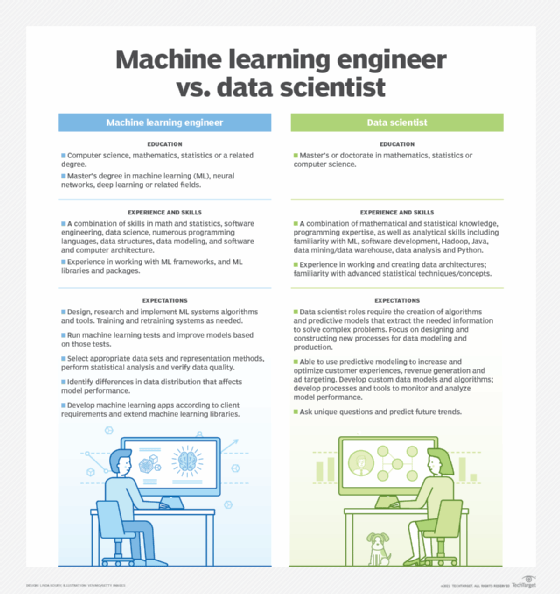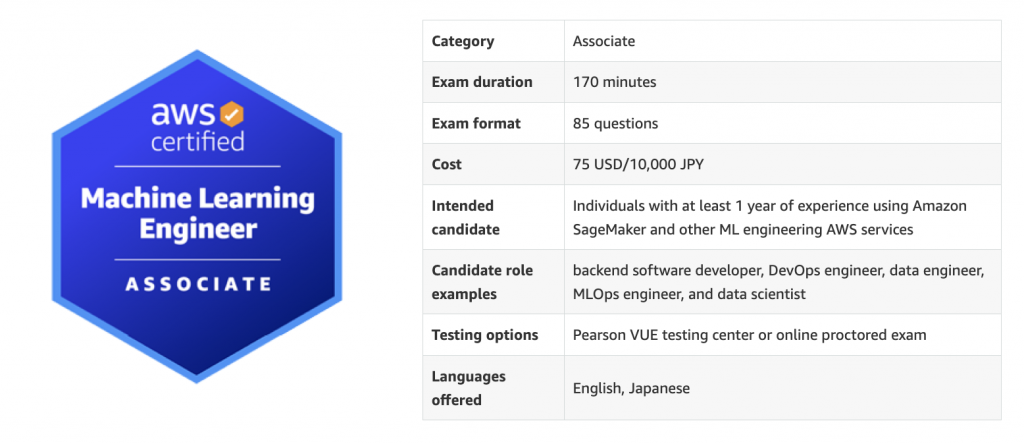All Categories
Featured
Table of Contents
- – The Best Strategy To Use For Ai And Machine Le...
- – The smart Trick of How To Become A Machine Lea...
- – Fascination About Practical Deep Learning For...
- – Machine Learning Course Fundamentals Explained
- – Machine Learning Engineering Course For Soft...
- – Some Known Details About 19 Machine Learning...
- – Things about Ai Engineer Vs. Software Engine...
Some people think that that's unfaithful. Well, that's my whole profession. If someone else did it, I'm going to use what that person did. The lesson is putting that apart. I'm requiring myself to analyze the feasible options. It's more concerning consuming the web content and attempting to use those concepts and less regarding locating a collection that does the job or searching for someone else that coded it.
Dig a bit deeper in the mathematics at the start, simply so I can build that structure. Santiago: Lastly, lesson number 7. This is a quote. It states "You have to recognize every detail of a formula if you desire to utilize it." And then I say, "I believe this is bullshit guidance." I do not believe that you need to recognize the nuts and screws of every formula before you use it.
I've been utilizing semantic networks for the lengthiest time. I do have a feeling of exactly how the gradient descent functions. I can not describe it to you right now. I would certainly need to go and inspect back to in fact obtain a much better instinct. That does not mean that I can not solve points using neural networks? (29:05) Santiago: Trying to compel people to think "Well, you're not going to achieve success unless you can describe every information of how this functions." It returns to our sorting example I think that's simply bullshit advice.
As a designer, I've dealt with many, several systems and I've used many, lots of points that I do not understand the nuts and bolts of how it functions, despite the fact that I recognize the influence that they have. That's the final lesson on that thread. Alexey: The funny thing is when I consider all these collections like Scikit-Learn the algorithms they make use of inside to execute, for instance, logistic regression or something else, are not the exact same as the formulas we research in artificial intelligence classes.
The Best Strategy To Use For Ai And Machine Learning Courses
Also if we tried to discover to obtain all these essentials of machine learning, at the end, the algorithms that these collections utilize are different. Santiago: Yeah, absolutely. I think we require a great deal much more pragmatism in the sector.

By the way, there are 2 various paths. I usually talk to those that want to work in the sector that intend to have their impact there. There is a path for researchers which is completely various. I do not risk to mention that due to the fact that I do not know.
Right there outside, in the sector, materialism goes a lengthy method for sure. (32:13) Alexey: We had a comment that stated "Feels even more like inspirational speech than chatting about transitioning." Perhaps we ought to switch. (32:40) Santiago: There you go, yeah. (32:48) Alexey: It is a great motivational speech.
The smart Trick of How To Become A Machine Learning Engineer In 2025 That Nobody is Discussing
One of things I wanted to ask you. I am taking a note to speak about progressing at coding. Yet initially, let's cover a number of things. (32:50) Alexey: Allow's begin with core tools and structures that you need to find out to really change. Let's say I am a software program designer.
I know Java. I understand just how to use Git. Perhaps I recognize Docker.
Santiago: Yeah, absolutely. I assume, number one, you ought to begin discovering a little bit of Python. Considering that you currently know Java, I do not assume it's going to be a huge shift for you.
Not since Python is the very same as Java, but in a week, you're gon na obtain a great deal of the differences there. You're gon na be able to make some development. That's leading. (33:47) Santiago: Then you get specific core tools that are going to be utilized throughout your entire career.
Fascination About Practical Deep Learning For Coders - Fast.ai
That's a library on Pandas for information control. And Matplotlib and Seaborn and Plotly. Those 3, or one of those 3, for charting and presenting graphics. You get SciKit Learn for the collection of device knowing algorithms. Those are devices that you're mosting likely to need to be utilizing. I do not suggest just going and learning more about them unexpectedly.
Take one of those training courses that are going to begin presenting you to some problems and to some core ideas of maker knowing. I don't keep in mind the name, but if you go to Kaggle, they have tutorials there for free.
What's great about it is that the only need for you is to know Python. They're mosting likely to present an issue and tell you how to utilize choice trees to address that specific issue. I assume that process is exceptionally powerful, because you go from no maker discovering background, to understanding what the problem is and why you can not solve it with what you recognize now, which is straight software application engineering practices.
Machine Learning Course Fundamentals Explained
On the various other hand, ML designers focus on building and deploying maker knowing models. They focus on training models with data to make predictions or automate tasks. While there is overlap, AI designers handle even more diverse AI applications, while ML designers have a narrower concentrate on machine knowing algorithms and their practical implementation.

Equipment understanding designers focus on establishing and deploying machine learning versions right into production systems. On the other hand, information researchers have a wider function that consists of data collection, cleansing, exploration, and structure versions.
As organizations progressively embrace AI and artificial intelligence modern technologies, the demand for knowledgeable experts expands. Maker understanding designers deal with cutting-edge tasks, add to innovation, and have competitive wages. Success in this field needs continual knowing and maintaining up with advancing technologies and strategies. Maker discovering duties are typically well-paid, with the possibility for high earning potential.
ML is essentially various from standard software development as it concentrates on training computer systems to learn from information, rather than programming explicit regulations that are performed systematically. Unpredictability of outcomes: You are probably used to writing code with foreseeable results, whether your function runs once or a thousand times. In ML, nonetheless, the outcomes are much less specific.

Pre-training and fine-tuning: Just how these versions are educated on substantial datasets and after that fine-tuned for specific tasks. Applications of LLMs: Such as text generation, sentiment analysis and info search and access.
Machine Learning Engineering Course For Software Engineers Can Be Fun For Everyone
The capacity to take care of codebases, combine adjustments, and solve conflicts is equally as essential in ML development as it is in conventional software tasks. The skills established in debugging and screening software application applications are very transferable. While the context could alter from debugging application reasoning to determining issues in data processing or model training the underlying concepts of methodical examination, theory screening, and iterative improvement coincide.
Machine learning, at its core, is heavily dependent on data and probability theory. These are vital for recognizing how formulas discover from data, make predictions, and assess their efficiency.
For those interested in LLMs, a detailed understanding of deep discovering architectures is advantageous. This consists of not just the technicians of neural networks yet also the design of certain designs for different use situations, like CNNs (Convolutional Neural Networks) for picture processing and RNNs (Frequent Neural Networks) and transformers for consecutive information and natural language processing.
You should understand these issues and discover methods for determining, minimizing, and communicating regarding prejudice in ML versions. This consists of the potential impact of automated decisions and the moral implications. Numerous models, particularly LLMs, need significant computational sources that are commonly given by cloud platforms like AWS, Google Cloud, and Azure.
Building these abilities will not just help with an effective change right into ML yet also ensure that developers can add effectively and responsibly to the advancement of this vibrant field. Theory is essential, but nothing beats hands-on experience. Start working with jobs that enable you to use what you've found out in a useful context.
Construct your projects: Beginning with simple applications, such as a chatbot or a message summarization device, and slowly increase complexity. The field of ML and LLMs is quickly evolving, with brand-new advancements and technologies arising regularly.
Some Known Details About 19 Machine Learning Bootcamps & Classes To Know
Contribute to open-source jobs or compose blog site articles about your learning journey and jobs. As you gain proficiency, start looking for possibilities to incorporate ML and LLMs right into your job, or look for brand-new duties concentrated on these innovations.

Vectors, matrices, and their duty in ML formulas. Terms like model, dataset, attributes, labels, training, inference, and recognition. Information collection, preprocessing methods, design training, evaluation processes, and implementation factors to consider.
Decision Trees and Random Woodlands: Intuitive and interpretable designs. Support Vector Machines: Optimum margin category. Matching trouble types with appropriate versions. Balancing performance and complexity. Basic framework of neural networks: neurons, layers, activation features. Split computation and forward breeding. Feedforward Networks, Convolutional Neural Networks (CNNs), Persistent Neural Networks (RNNs). Picture recognition, sequence prediction, and time-series evaluation.
Continuous Integration/Continuous Release (CI/CD) for ML workflows. Model surveillance, versioning, and performance tracking. Discovering and attending to modifications in design performance over time.
Things about Ai Engineer Vs. Software Engineer - Jellyfish

Program OverviewMachine understanding is the future for the following generation of software program professionals. This program works as an overview to artificial intelligence for software application designers. You'll be presented to three of the most pertinent components of the AI/ML self-control; managed understanding, neural networks, and deep learning. You'll grasp the differences in between traditional programs and artificial intelligence by hands-on growth in monitored understanding before building out complex dispersed applications with semantic networks.
This training course acts as a guide to maker lear ... Program More.
Table of Contents
- – The Best Strategy To Use For Ai And Machine Le...
- – The smart Trick of How To Become A Machine Lea...
- – Fascination About Practical Deep Learning For...
- – Machine Learning Course Fundamentals Explained
- – Machine Learning Engineering Course For Soft...
- – Some Known Details About 19 Machine Learning...
- – Things about Ai Engineer Vs. Software Engine...
Latest Posts
The Top 50+ Software Engineering Interview Questions And Answers
Anonymous Coding & Technical Interview Prep For Software Engineers
The 10 Types Of Technical Interviews For Software Engineers
More
Latest Posts
The Top 50+ Software Engineering Interview Questions And Answers
Anonymous Coding & Technical Interview Prep For Software Engineers
The 10 Types Of Technical Interviews For Software Engineers